Garden Decking Guide
Garden Decking Guide
Introduction
Decking can transform any outdoor living space. It's a practical and beautiful way to extend a home's living area and helps to make the most of sloped or uneven gardens. But, before you get started, it's best to do some research to ensure you know all your options.
This guide tells you everything you need to know about garden decking. It covers the different garden decking styles, what they’re made of, and the pros and cons. You’ll learn how to work out how much decking you need for your project and the things you need to consider before buying. Finally, we’ll give you some tips on how to clean decking.
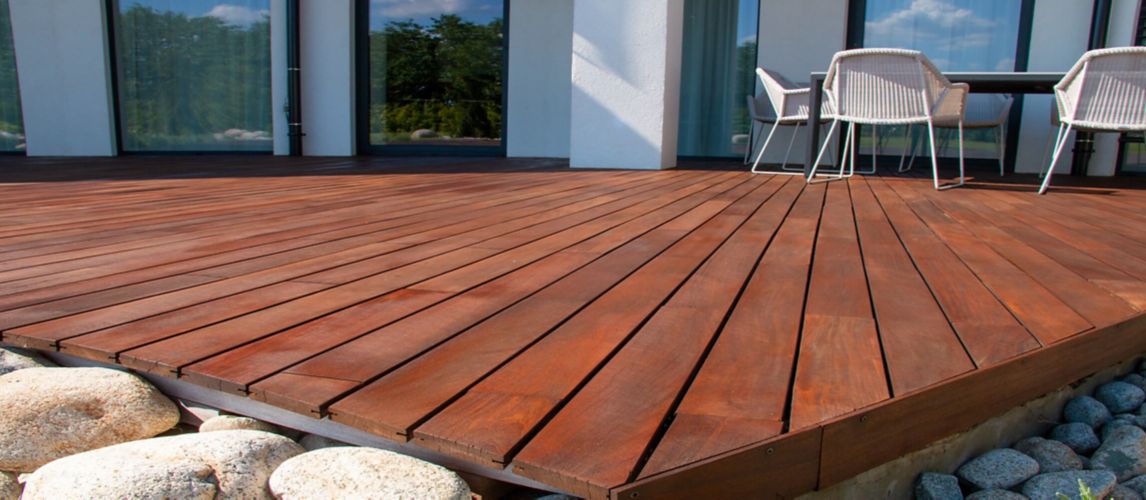
Garden Decking Styles
There are three decking styles available. Their main difference is how they look and how easy they are to build. So, the style you choose will depend on your personal preference.

Decking boards
Decking boards are long planks made of wood or composite material (see the next section for more information about materials). They suit all decking projects, whether a small, simple square deck or a large, raised, irregularly shaped deck. The installation of deck boards can be simple or complex, depending on the design of the deck you're building. But they need to be installed on deck joists or a specially constructed frame if it's raised. The boards come in packs and vary in length, width and thickness.
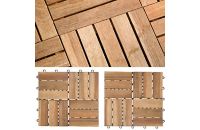
Decking tiles
Decking tiles are square and made of wood. They’re ideal for small decks and can be installed over a wood base or on an existing surface, such as stone, brick or concrete, making them quick and easy to install. The tiles come in packs and are available in a variety of sizes.
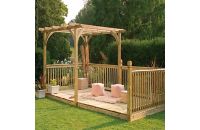
Decking kits
Decking kits are a convenient and practical option for decking as they come supplied with all the parts required for installation. Available deck kits include decking board kits, decking tile kits and decking joist kits. There are also kits available that include balustrades and built-in pergolas. They come in various sizes, so you can simply pick the size you want to suit the space.
How to Choose Types of Decking
One of the first decisions you’ll make when buying decking is which material you want. There are two types of decking material available: timber and composite. And they have different attributes and features.
In this section, we take a closer look at each material and highlight its pros and cons to help you decide which one is best for your needs.
Timber Decking Options
When choosing timber decking, you have several options. The first option is the type of wood. Choose between:
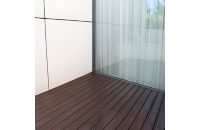
Softwoods which usually come from Europe. They can include woods such as Scots pine, Norway spruce or maritime pine. They are light coloured woods that are sensitive to the elements, so they must be treated.
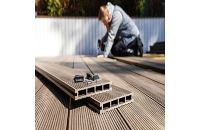
Hardwoods also from Europe. They can include woods such as oak, chestnut and black locust. They are more expensive than softwoods, but they're more durable, so they will last longer. However, they need to be treated regularly otherwise, tannins naturally held in the wood will rise to the surface and spoil their look.
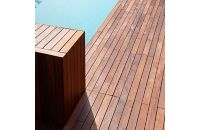
Exotic woods come from more tropical climates. These can include woods such as Ipe, teak and mahogany. They're dark coloured woods that are naturally rot-proof and insect repelling. They're durable and long-lasting but don't usually come treated. So, to stop the wood fading, it will need to be coated with a penetrating wood oil.
When buying timber decking, the second thing to check is that it comes from a sustainable source. There are two wood certification schemes to look out for: The Forest Stewardship Council (FSC®) and The Programme for the Endorsement of Forest Certification (PEFC™).
The third option to choose is the class of timber. There are two ways wood is classified:
- Strength and durability: building regulations require a C16 timber rating for decks above 600mm in height. Higher-strength classes of C18 or C24 are needed for large expanses of decking for commercial use.
- Resistance to wood-destroying fungi: this classification ranges from class 1 – very durable to class 5 – not durable. Decking must be at least class 3 (moderately durable), which means it's suitable for use above ground. European soft and hardwood with this classification will have been treated to withstand the elements. The wood is kiln-dried and pressure-treated to remove excess moisture to prevent shrinking and warping, then treated against fungal decay and insect attack. Exotic woods are not usually pre-treated as they are naturally rot-proof.
Finally, choose the look and finish. Timber decking comes in different colours (usually dictated by the wood type) and finishes. Timber boards or tiles can have smooth surfaces, or you can choose a fully ribbed or grooved design. Some are even reversible, so you can alternate between the two looks. And there are low slip boards, which are ideal for use with hot tubs.
Timber decking pros:
- Authentic wood look
- Damaged boards or tiles can easily be repaired
- Environmentally friendly
- Can be painted or stained in any colour you choose
- Easy to install
- Strong
- Long-lasting
Timber decking cons:
- Can fade, crack, splinter or warp without regular maintenance
- It’s slippery when wet
- Requires sanding, re-staining or oiling annually
Composite Decking Options
Composite decking is made from a combination of recycled wood particles and a plastic resin that makes it extremely hard, durable and long-lasting. It's only available as deck boards but comes in various colours. It's designed to look like natural wood but doesn't have any of the characteristics of wood that make it unique, such as knots.
Composite decking pros:
- It doesn’t fade, warp, split or splinter
- Rot-proof
- Scratch and stain-resistant
- Low maintenance (never needs sanding, staining or oiling)
- Easy to clean
- Some can be slip-resistant (even when wet)
- Very long-lasting
Composite decking cons:
- Requires more structural support than wood
- Cannot be repaired
- Less environmentally friendly than wood
- More expensive than wood
How Long Does Decking Last?
The length of time decking can last will depend on the type and quality of the decking you buy and how well it’s looked after. Composite decking can last from 25-30 years with very minimal upkeep, other than giving it an occasional clean. The lifespan of timber decking varies from around 10-30 years. Softwoods or decking that's left untreated will be at the lower end of that scale, while hardwoods or decking that's properly maintainted with decking treatment will be at the higher end.
Signs decking needs replacing
Over its lifetime, garden decking will suffer a lot of wear and tear. So, it’s essential to carry out regular inspections to ensure it remains safe to use.
Here’s a list of things to check:
- How secure are the fixtures? Excessive movement when you walk on the deck, wobbly balustrades or railings and creaking or moving steps are all signs of a weak structure. If this is the case, you may need to replace the entire deck and its supporting frame.
- Does it flex more than it should? Walk up and down the deck. If any areas feel bouncy or are bending more than they should, the planks or tiles should be replaced or reinforced.
- Are there any areas of rot? Rot will eat through timber decking, making it weak and prone to breaking. Look for areas that feel spongy and press a metal tool into the wood. If it gives way, the wood will need to be replaced. If the rot is only in a small area. You can replace individual planks or tiles. But if it’s more widespread, you should replace the whole deck.
- Could it have been treated with chromatid copper arsenate? If the timber decking was built before 2004, it might have been treated with a toxic chemical called chromatid copper arsenate. If that's the case, you may want to replace it.
- Are there signs of splinters or rusted nails? Splinters and rusted nails are signs that the decking is getting old. If splinters aren't widespread, they can be sanded down to repair the deck instead of replacing it. Likewise, rusty nails or screws should be removed and replaced with new ones to prevent the deck's structure from being weakened by corrosion.
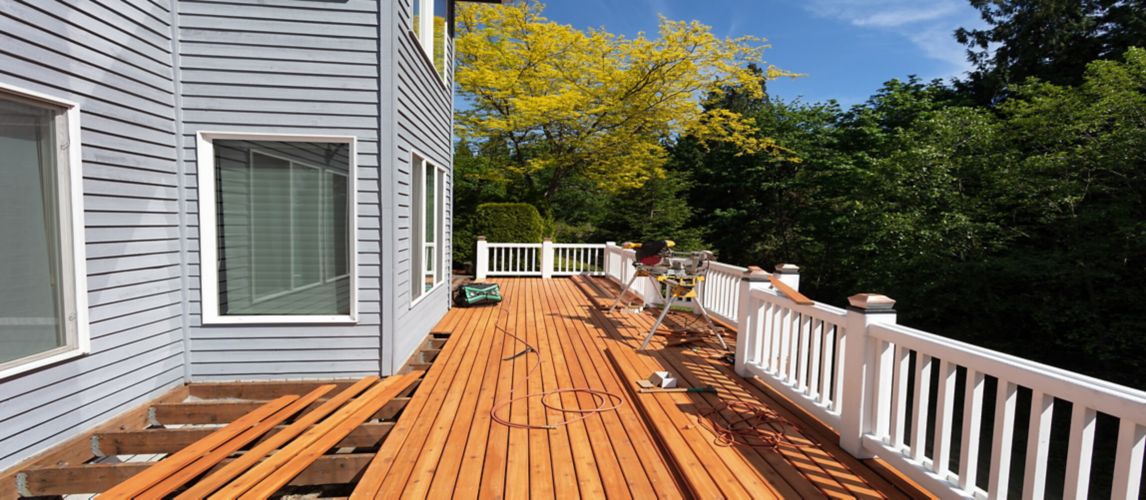
How Many Decking Boards do I Need?
Follow the steps below to work out how many deck boards you need:
- Measure the width and length of the area where the decking will go.
- Multiply the width and length to calculate the total square metres you need to cover.
- Add 10% to the square metre measurement to allow for cuts.
- Buy enough decking packs to cover that square meterage (each pack will tell you how many square metres it covers).
What Size Timber do I Need For The Decking Frame?
A decking frame should be constructed from wood with a strength and durability class of at least C16. Use 4x2 (45x95mm) for low-level decking frame joists and 4x6 (45x145mm) for a raised deck.
To work out the total length of timber you'll need for a low-level base, add up all the lengths of the sides of the decking (these are the deck bearers). Then allow lengths of timber for the decking joists, which should be spaced 400mm apart across the base.
What to Consider When Buying Decking
Before you buy garden decking, there are a few more things to consider:
-
Have you set the foundations and frame for your decking correctly? The type of foundations you need for your decking will depend on the kind of ground it will be placed on and whether it's a low-level or raised deck. For a low-level deck, you can usually just level the ground off and lay weed control fabric and gravel under the deck. A raised deck will require footings to ensure it's stable.
-
Which way should decking be laid? With decking boards, you can choose which way to lay them. They can be lengthways, widthways, diagonally, in a chevron design or any design you like. Decking tiles can also be mixed up so the slats can run in the same direction or at 90-degree angles to each other.
-
What about decking protection and maintenance? Most softwood and hardwood garden decking comes pre-treated, so you don’t need to stain or protect it when it’s first built, but you will need to apply end coat preservative on cut wood or drilled holes. If you want to stain the deck, you should wait for 6-months. Exotic woods aren’t usually pre-treated, so they’ll need to be coated with a penetrating wood oil to protect them from fading.
-
Have you allowed for drainage? Decking should be built on an area of ground with good drainage. But in addition to that, the decking itself must be made so that it’s slightly sloping in one direction (approx. 1cm) so rainwater can easily run off it.
-
What other decking materials do I need? Consider other materials you may need when building the decking alongside using a decking kit. For example: Deck bearers: the outside frame of the deck. Decking risers: to help the joists reach the desired height on uneven ground. Decking joists: the timbers that go across the bearers to support the deck. Decking screws: choose specialist decking screws to ensure they are corrosion-resistant. Decking posts, post caps, balustrades, spindles, hand and base rails: to add railings to raised decking for safety. Decking steps: for raised decking. Decking lights: to add a finishing touch
How to Clean Decking
Once garden decking is installed, it will require regular cleaning to keep it looking its best. The amount of cleaning and how you clean will depend on the type of decking.
How To Clean Timber Decking
We recommend timber decking is given a deep clean once or twice a year as follows:
- Start by using a stiff brushed broom to sweep the deck and remove loose dirt and debris.
- Use a specialist timber decking cleaning detergent and a stiff brush to remove grease, ground in dirt, algae and fungus. The decking cleaner will also prevent re-growth.
- Rinse the detergent away with clean water. You can do this using a garden hose or a pressure washer. But, if you use a pressure washer, ensure the pressure is no higher than 100 bar, and the nozzle is at least 12” from the deck’s surface.
In addition to cleaning, timber decking will need to be re-oiled or stained every few years to prevent water damage as follows:
- Start by giving the decking a deep clean as described above.
- Once the decking is dry, strip or sand off the surface using a deck finish stripper or sander.
- Next, apply a specialist decking stain or preservative to enhance the colour of the wood and prevent cracking, flaking and fading. You can apply it using a timber brush. Or, for quick application on smooth decking, use a decking painting pad.
- If the decking is hardwood, also apply an annual coat of decking oil.
- Finally, seal the decking with a decking protector. It contains waxes to repel water and algaecide to prevent mould growth.
How to Clean Composite Decking
Composite decking needs very little maintenance other than an occasional clean. Here are some tips on how to clean composite decking:
- Start by using a stiff brushed broom to sweep the deck and remove loose dirt and debris.
- Remove stuck-on dirt or marks such as tree sap and food spills as soon as possible with a cloth or brush and soapy water.
- Tough or sticky marks can be scrubbed with a scrubbing brush and rinsed well with clean water.
- Take care if you use a pressure washer to clean composite decking as they can damage the surface. If you do use a pressure washer, don’t use anything above a 100 bar pressure rating, and keep the nozzle at least 12” away from the deck’s surface.
